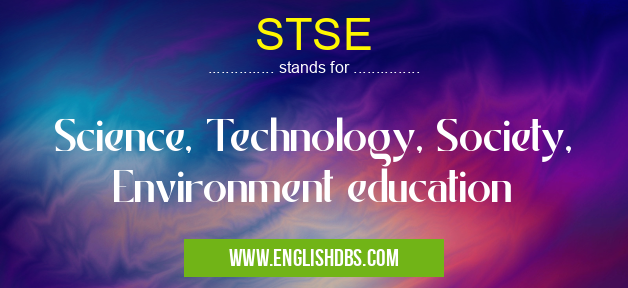What does STSE mean in ACADEMIC & SCIENCE
STSE (Science, Technology, Society, Environment) education is an approach to educational instruction that seeks to make students aware of the societal and environmental implications of scientific and technological advancement. STSE education encourages students to examine the interplay between science, technology, society and environment in order to better understand their place in the world and gain a more meaningful understanding of the science taught in school.

STSE meaning in Academic & Science in Academic & Science
STSE mostly used in an acronym Academic & Science in Category Academic & Science that means Science, Technology, Society, Environment education
Shorthand: STSE,
Full Form: Science, Technology, Society, Environment education
For more information of "Science, Technology, Society, Environment education", see the section below.
Essential Questions and Answers on Science, Technology, Society, Environment education in "SCIENCE»SCIENCE"
What does STSE stand for?
STSE stands for Science, Technology, Society, Environment.
How does STSE education differ from traditional approaches to teaching science?
Unlike traditional approaches which focus solely on scientific principles and facts, STSE education encourages students to critically examine how science is intertwined with society and the environment.
What is the purpose of STSE education?
The purpose of STSE education is to enable students to develop a greater understanding of how new scientific discoveries can raise complex ethical issues or have unintended environmental impacts. Through this approach to learning, students are able to develop critical thinking skills while exploring real-world examples of scientific progress.
How can teachers incorporate STSE concepts into their classes?
Teachers can incorporate STSE concepts into their classes by introducing case studies that explore how new technology has affected our lives or how societies have grappled with ethical issues raised by recent advances in biotechnology. By engaging their classrooms in lively debates about these topics, teachers help foster an appreciation for the natural world among their students.
What are some common caveats associated with implementing an STSE approach?
Implementing an STSE approach requires a shift from focusing solely on knowledge acquisition towards promoting student-directed exploration and inquiry into science's application in society. This can be challenging for many teachers who may not be comfortable deviating from more traditional methods of instruction. Additionally, it can sometimes be difficult for teachers without formal training in social sciences or humanities fields to lead discussions about related topics in those disciplines.
Final Words:
Through its emphasis on examining real-world application of scientific knowledge, STSE education helps promote critical thinking skills while bolstering students' understanding of how their actions affect society and nature at large. Even though it requires a departure from more traditional approaches, incorporating elements from this type of instruction into classroom settings can provide meaningful opportunities for learning that are engaging and relevant for all types of learners.
